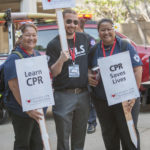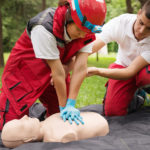Lifesaving Strategies
Increasing sudden cardiac arrest survival rates depends largely on education: telling more people about the lifesaving benefits of CPR and training them in proper CPR technique. Part of our mission is transforming knowledge into coordinated action—and the following programming and training resources are ideal examples of that transformation. It’s important to note that training isn’t just for bystanders; programs also exist to improve dispatch-assisted CPR and in-hospital resuscitation response. The reason for that is simple: by working together, we can save more lives.
Learn CPR

The more people trained in CPR the more survivors of sudden cardiac arrest there will be. To be ready to save someone when needed we provide the basics of hands-only CPR and how to use an automated external defibrillator (AED) in an emergency situation.
Teaching CPR in schools is an effective way to reach large groups of people at one time. Aside from preparing students to act in the event of a sudden cardiac arrest emergency, CPR skills can also equip students to meet after-school or summer job requirements. A number of CPR training programs currently exist, but it’s equally important to stay focused on legislation that can help expand in-school CPR training to more states.
CPR in Schools

CPR in Schools

Teaching CPR in schools is an effective way to reach large groups of people at one time. Aside from preparing students to act in the event of a sudden cardiac arrest emergency, CPR skills can also equip students to meet after-school or summer job requirements. A number of CPR training programs currently exist, but it’s equally important to stay focused on legislation that can help expand in-school CPR training to more states.
Community Training

The more people trained in CPR, the more we can improve sudden cardiac arrest survival rates. And that’s why community training programs are so critical in reaching—and educating—as many people as possible. We’ve compiled information and resources about a variety of CPR training programs so you can learn more about available options, including how to start a program in your area.
Mobile CPR
Bring CPR training and resources directly to the people who need them.
PAD Programs
Public Access Defibrillation (PAD) programs increase access to lifesaving equipment.
CPR Around the World
Spread the word about CPR training in your community and beyond.
Communities may have cardiac arrest response protocols and programming in place, but it’s not always easy to assess performance. An effective solution is to identify and educate Resuscitation Officers in hospital code teams and EMS leadership, equipping them with the leadership tools to better manage sudden cardiac arrest and increase survival rates.
Resuscitation Leadership Programs

Resuscitation Leadership Programs

Communities may have cardiac arrest response protocols and programming in place, but it’s not always easy to assess performance. An effective solution is to identify and educate Resuscitation Officers in hospital code teams and EMS leadership, equipping them with the leadership tools to better manage sudden cardiac arrest and increase survival rates.
Dispatch CPR

Every second counts when responding to sudden cardiac arrest. And if a bystander isn’t trained in CPR, they rely on 911 responders to offer step-by-step instructions. Dispatch-assisted CPR or telephone CPR programs help improve the efficacy of these instructions, ensuring they’re consistently and properly delivered. That’s why TCPR programs have been associated with significantly increased rates of bystander CPR and survival.
Find out more about dispatch-assisted CPR and available programs
It might seem unnecessary to refine resuscitation response in hospitals, where medical personnel have been thoroughly trained in life-saving protocol. Yet by examining current in-hospital resuscitation response—and identifying opportunities for improvement—can have a positive impact on a variety of resuscitation metrics.
Learn more about in-hospital improvement at the University of Pennsylvania
In Hospital Strategies

In Hospital Strategies

It might seem unnecessary to refine resuscitation response in hospitals, where medical personnel have been thoroughly trained in life-saving protocol. Yet by examining current in-hospital resuscitation response—and identifying opportunities for improvement—can have a positive impact on a variety of resuscitation metrics.
Learn more about in-hospital improvement at the University of Pennsylvania
